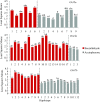Odorant receptor polymorphisms and natural variation in olfactory behavior in Drosophila melanogaster
- PMID: 20628035
- PMCID: PMC2954467
- DOI: 10.1534/genetics.110.119446
Odorant receptor polymorphisms and natural variation in olfactory behavior in Drosophila melanogaster
Abstract
Animals perceive and discriminate among a vast array of sensory cues in their environment. Both genetic and environmental factors contribute to individual variation in behavioral responses to these cues. Here, we asked to what extent sequence variants in six Drosophila melanogaster odorant receptor (Or) genes are associated with variation in behavioral responses to benzaldehyde by sequencing alleles from a natural population. Sequence analyses showed signatures of deviations from neutrality for Or42b and Or85f, and linkage disequilibrium analyses showed a history of extensive recombination between polymorphic markers for all six Or genes. We identified polymorphisms in Or10a, Or43a, and Or67b that were significantly associated with variation in response to benzaldehyde. To verify these associations, we repeated the analyses with an independent set of behavioral measurements of responses to a structurally similar odorant, acetophenone. Association profiles for both odorants were similar with many polymorphisms and haplotypes associated with variation in responsiveness to both odorants. Some polymorphisms, however, were associated with one, but not the other odorant. We also observed a correspondence between behavioral response to benzaldehyde and differences in Or10a and Or43a expression. These results illustrate that sequence variants that arise during the evolution of odorant receptor genes can contribute to individual variation in olfactory behavior and give rise to subtle shifts in olfactory perception.
Figures





Similar articles
-
Genetic variation in odorant receptors contributes to variation in olfactory behavior in a natural population of Drosophila melanogaster.Chem Senses. 2012 Mar;37(3):229-40. doi: 10.1093/chemse/bjr097. Epub 2011 Oct 29. Chem Senses. 2012. PMID: 22038943 Free PMC article.
-
Natural variation in odorant recognition among odorant-binding proteins in Drosophila melanogaster.Genetics. 2010 Mar;184(3):759-67. doi: 10.1534/genetics.109.113340. Epub 2009 Dec 21. Genetics. 2010. PMID: 20026676 Free PMC article.
-
Association of polymorphisms in odorant-binding protein genes with variation in olfactory response to benzaldehyde in Drosophila.Genetics. 2007 Nov;177(3):1655-65. doi: 10.1534/genetics.107.079731. Epub 2007 Aug 24. Genetics. 2007. PMID: 17720903 Free PMC article.
-
Elements of olfactory reception in adult Drosophila melanogaster.Anat Rec (Hoboken). 2013 Sep;296(9):1477-88. doi: 10.1002/ar.22747. Epub 2013 Jul 31. Anat Rec (Hoboken). 2013. PMID: 23904114 Review.
-
Odor and pheromone detection in Drosophila melanogaster.Pflugers Arch. 2007 Aug;454(5):749-58. doi: 10.1007/s00424-006-0190-2. Epub 2007 Jan 5. Pflugers Arch. 2007. PMID: 17205355 Review.
Cited by
-
Identification and Differential Expression of a Candidate Sex Pheromone Receptor in Natural Populations of Spodoptera litura.PLoS One. 2015 Jun 30;10(6):e0131407. doi: 10.1371/journal.pone.0131407. eCollection 2015. PLoS One. 2015. PMID: 26126192 Free PMC article.
-
Natural variation, functional pleiotropy and transcriptional contexts of odorant binding protein genes in Drosophila melanogaster.Genetics. 2010 Dec;186(4):1475-85. doi: 10.1534/genetics.110.123166. Epub 2010 Sep 24. Genetics. 2010. PMID: 20870963 Free PMC article.
-
Evolutionary ecology of chemosensation and its role in sensory drive.Curr Zool. 2018 Aug;64(4):525-533. doi: 10.1093/cz/zoy048. Epub 2018 Jul 2. Curr Zool. 2018. PMID: 30108633 Free PMC article.
-
Drosophila olfaction: past, present and future.Proc Biol Sci. 2022 Dec 21;289(1989):20222054. doi: 10.1098/rspb.2022.2054. Epub 2022 Dec 14. Proc Biol Sci. 2022. PMID: 36515118 Free PMC article. Review.
-
Stability of olfactory behavior syndromes in the Drosophila larva.Sci Rep. 2023 Feb 10;13(1):2398. doi: 10.1038/s41598-023-29523-x. Sci Rep. 2023. PMID: 36765192 Free PMC article.
References
-
- Abaffy, T., A. Malhotra and C. W. Leutje, 2007. The molecular basis for ligand specificity in a mouse olfactory receptor. J. Biol. Chem. 282 1216–1224. - PubMed
-
- Andolfatto, P., 2001. Contrasting patterns of X-linked and autosomal nucleotide variation in Drosophila melanogaster and Drosophila simulans. Mol. Biol. Evol. 18 279–290. - PubMed
-
- Anholt, R. R. H., and T. F. C. Mackay, 2004. Quantitative genetic analyses of complex behaviours in Drosophila. Nat. Rev. Genet. 5 838–849. - PubMed
-
- Ali, M. A., 1978. Sensory Ecology: Review and Perspectives. Plenum Press, New York.
Publication types
MeSH terms
Substances
Grants and funding
LinkOut - more resources
Full Text Sources
Molecular Biology Databases

